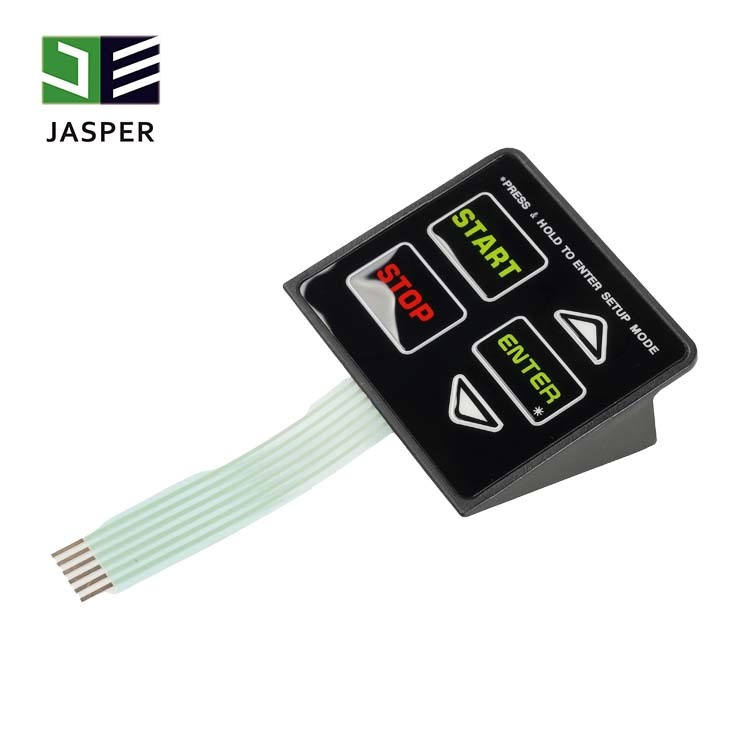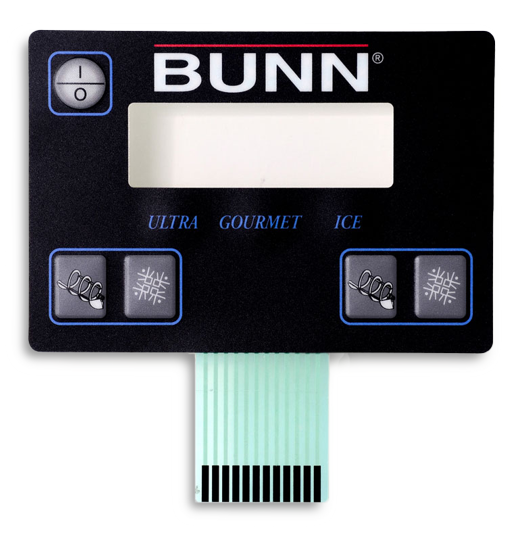End-to-End Membrane Switch Manufacturer for Targeted Applications
End-to-End Membrane Switch Manufacturer for Targeted Applications
Blog Article
Understanding the Relevance of Membrane Switch in Modern Electronic Devices and Their Applications
Membrane switches over function as a vital part in modern electronics, supplying a reliable interface for individual communication. Their adjustable and light-weight nature makes them appropriate for a series of applications throughout varied industries. Comprehending their vital elements and advantages can supply understandings into their expanding importance. As technology proceeds to development, the development of Membrane switches over questions about their future applications and layout advancements. What lies ahead in this dynamic field?

What Are Membrane Switches?
Membrane switches are important parts in modern-day electronics, serving as customer interfaces that assist in communication between users and tools. These buttons include numerous layers, including a visuals overlay, a sticky layer, and a circuit layer, all of which job together to produce a functional and long lasting user interface. The design enables for a flat, inconspicuous option that can be personalized regarding size, form, and aesthetic look, making them ideal for various applications, from consumer electronic devices to medical devices. The responsive responses given by Membrane switches boosts user experience, while their resistance to dust and moisture makes them perfect for testing atmospheres. Membrane buttons can include functions such as backlighting and printed graphics, better broadening their usability. Their convenience and robustness make them a preferred selection in industries where reliability and ease of use are vital, ultimately adding to the seamless operation of contemporary digital devices.
Trick Elements of Membrane Switches
While numerous components contribute to the capability of a membrane button, three primary layers play substantial duties in its style and procedure. The top layer, commonly made from a resilient polymer, serves as the user interface for user communication, typically including published symbols and graphics. Underneath this is the spacer layer, which preserves the essential range between the top layer and the circuit layer. This spacer layer assurances that the switch turns on only when pressed, avoiding unexpected inputs. The circuit layer contains conductive traces that finish the electric circuit when the leading layer is depressed. These traces can be made from numerous materials, including copper or silver. With each other, these elements create a reliable and robust tool that is portable and flexible, suitable for a large range of electronic applications, from family home appliances to clinical devices. Recognizing these key elements is vital for appreciating the general capability of Membrane switches.
Advantages of Using Membrane Switches Over

Membrane Switch Manufacturing Refine
Recognizing the Membrane switch manufacturing procedure exposes the detailed actions entailed in generating these necessary components. The procedure typically starts with the layout phase, where designs and requirements are created utilizing specialized software program. Following this, the visuals overlay is printed on a flexible substratum, usually utilizing high-resolution printing strategies to guarantee clarity and precision.Next, the glue layers are used, which offer to bond the different elements together. The circuit layers, made from conductive inks or products, are then published onto a different substrate. These layers are meticulously aligned and laminated flooring to create a functional switch.After assembly, the buttons go through checking to verify functionality and resilience. Quality control steps are executed throughout the process to identify and remedy any type of flaws. Lastly, the finished Membrane buttons are packaged and prepared for circulation, all set to fulfill the needs of contemporary digital applications.
Applications of Membrane Switches in Various Industries
Membrane switches are progressively made use of across different sectors, particularly in clinical devices and customer electronic devices. In the medical field, they supply dependable control user interfaces for tools that require exact procedure. In a similar way, in consumer electronic devices, these switches improve user interaction by providing responsive and sleek interfaces.
Medical Tools Control
Countless contemporary medical devices make use of Membrane switches for structured procedure and improved customer communication. These buttons provide a trustworthy, resilient interface for a selection of applications, including analysis tools, client surveillance systems, and medical tools. Their adjustable styles permit for specific formats that can accommodate the distinct needs of healthcare experts, making certain user-friendly navigating and effective access to my latest blog post important features. Furthermore, Membrane switches are immune to pollutants, making them appropriate for sterile atmospheres. The tactile comments they supply can boost customer confidence, minimizing the risk of mistakes throughout important clinical procedures. Overall, the integration of Membrane buttons in medical equipment significantly contributes to boosted operational efficiency and individual safety in medical care setups.
Consumer Electronic Devices Interfaces
In the domain name of consumer electronic devices, Membrane switches play an important function in enhancing interface throughout a wide range of tools. These buttons are indispensable to products such as remote controls, microwaves, and video gaming consoles, offering a straightforward and reliable user interface. Their layout enables a smooth integration of graphics and performance, making it possible for makers to produce streamlined, modern looks without endangering usability. Membrane buttons are additionally understood for their longevity, frequently holding up against considerable usage and exposure to numerous ecological problems. In addition, they can include features like backlighting and tactile responses, further improving the individual experience. As consumer demands for innovative yet user-friendly interfaces expand, Membrane switches proceed to be an essential component beforehand digital device performance.
Style Considerations for Membrane Switches Over
Creating reliable Membrane changes needs mindful interest to different elements that affect both performance and user experience. One important consideration is the option of products, as they can influence toughness, tactile feedback, and visual allure. Choosing an appropriate adhesive is vital for ensuring long-term attachment and resistance to environmental factors.In enhancement, the layout and design of the switch should accommodate individual interaction, with switch sizes and spacing maximized for convenience of usage. The incorporation of graphics and labeling need to focus on clearness and visibility under various illumination conditions.Consideration of electric qualities, such as actuation force and button level of sensitivity, will improve the responsiveness of the Membrane switch. Additionally, the design should fit manufacturing procedures to ensure cost-effectiveness and prompt production. In general, a well-balanced design enhances both the customer and the functionality experience of Membrane switches in modern-day electronics.

Future Trends in Membrane Switch Modern Technology
As innovation continues to advance, Membrane buttons are positioned to incorporate brand-new innovations that will improve their functionality and application in various areas. One substantial pattern is the consolidation of durable and flexible products, which will certainly enhance the life-span and integrity of these switches. Enhanced surface structures and adjustable graphics are additionally expected, enabling even more click now intuitive user interfaces.Moreover, the integration of clever innovation, such as touch-sensitive surface areas and haptic feedback, is expected to improve user interaction, making Membrane switches much more receptive and appealing. In addition, advancements in published electronics will enable a lot more complicated circuitry within thinner accounts, additionally expanding layout possibilities.Sustainability will certainly likewise play an important function in future growths, as manufacturers check out environment-friendly products and production processes. In general, these patterns will certainly guarantee that Membrane switches over continue to be appropriate and important in an interconnected and progressively digital world.
Frequently Asked Inquiries
Exactly How Do Membrane Switches Compare to Standard Mechanical Switches?
Membrane changes deal advantages over standard mechanical buttons, consisting of decreased size, lighter weight, and boosted sturdiness. They normally supply a sealed surface area, improving resistance to dirt and moisture, making them excellent for varied applications.
What Products Are Commonly Used in Membrane Switch Construction?

Can Membrane Switches Over Withstand Extreme Environmental Conditions?
Membrane switches can hold up against extreme environmental conditions, relying on their design and materials. Premium constructions frequently feature sturdiness versus temperature level changes, moisture, and exposure to chemicals, making them appropriate for various demanding applications throughout sectors.
The Length Of Time Do Membrane Switches Over Usually Last Prior To Failure?
Membrane switches usually exhibit a life expectancy varying from 1 to 10 million actuations, depending on aspects such as use regularity, ecological problems, and manufacturing top quality. Normal upkeep can expand their durability and operational integrity considerably.
Are Membrane Changes Customizable for Particular Applications?
Membrane buttons are indeed adjustable for details applications. They can be customized in size, performance, and design, allowing suppliers to satisfy special user demands and improve product looks while maintaining operational performance and longevity. Membrane buttons are crucial parts in modern-day electronics, serving as individual interfaces that promote interaction in between users and tools. The tactile feedback given by Membrane switches over improves individual experience, while their resistance to dirt and moisture makes them suitable for testing environments. The unification of graphics and labeling need to focus on quality and visibility under see it here various illumination conditions.Consideration of electrical attributes, such as actuation force and button level of sensitivity, will certainly boost the responsiveness of the Membrane button. Boosted surface appearances and customizable graphics are also expected, permitting for even more user-friendly individual interfaces.Moreover, the combination of wise innovation, such as touch-sensitive surface areas and haptic feedback, is anticipated to boost customer interaction, making Membrane switches extra receptive and appealing. Membrane switches over offer benefits over standard mechanical buttons, including decreased size, lighter weight, and boosted sturdiness.
Report this page